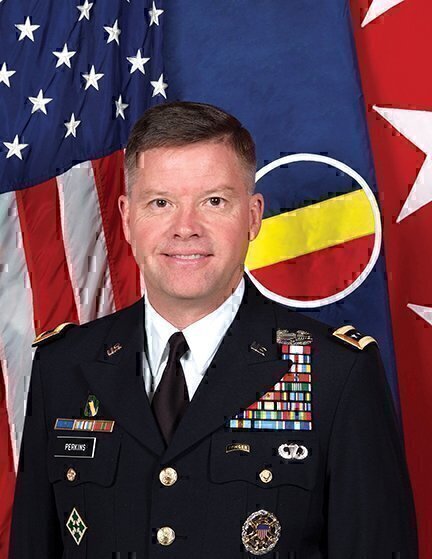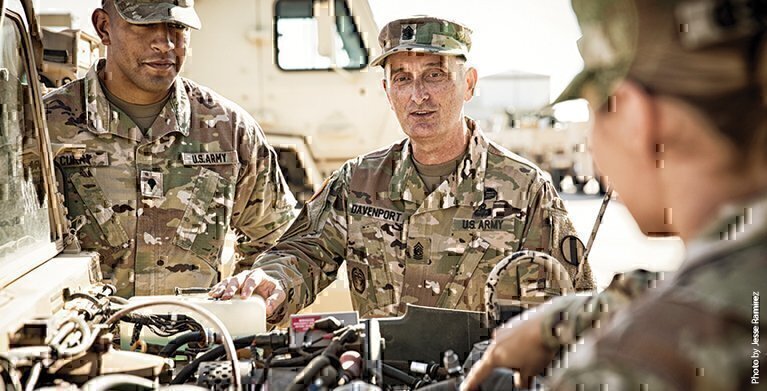At Army University you can learn to fly a helicopter, drive a tank, fire a cannon, fix a heavy truck, jump from an airplane in full combat gear, or command a division. Try that at Penn State.
Just don’t look for a giant, central campus like at Penn State. Launched in July 2015 to better educate its soldiers and civilians, the Army University is spread over 50 states. It coordinates and synchronizes the more than 70 schools and 100 training institutions run by the U.S. Army Training and Doctrine Command (TRADOC) under one governance structure. The structure mirrors civilian higher learning institutions, complete with a chancellor, provost, vice provost and subordinate centers and schools. And the name is
no accident.
“We want the citizens of our country to realize that their sons and daughters that they entrust to us are receiving first-class training. They are prepared,” says Command Sgt. Maj. David Davenport, the command sergeant major for TRADOC.
The Army’s professional education system hadn’t changed for two decades. Putting most of the Army’s military education system under one umbrella will allow it to provide academic credit and credentialing for a soldier’s military education, training and experience. Eventually Army University will become an accredited, degree-granting institution.[/fusion_text][/fullwidth][fullwidth background_color=”” background_image=”” background_parallax=”none” enable_mobile=”no” parallax_speed=”0.3″ background_repeat=”no-repeat” background_position=”left top” video_url=”” video_aspect_ratio=”16:9″ video_webm=”” video_mp4=”” video_ogv=”” video_preview_image=”” overlay_color=”” overlay_opacity=”0.5″ video_mute=”yes” video_loop=”yes” fade=”no” border_size=”0px” border_color=”” border_style=”” padding_top=”20″ padding_bottom=”20″ padding_left=”” padding_right=”” hundred_percent=”no” equal_height_columns=”no” hide_on_mobile=”no” menu_anchor=”” class=”” id=””][two_third last=”no” spacing=”yes” center_content=”no” hide_on_mobile=”no” background_color=”” background_image=”” background_repeat=”no-repeat” background_position=”left top” hover_type=”none” link=”” border_position=”all” border_size=”0px” border_color=”” border_style=”” padding=”” margin_top=”” margin_bottom=”” animation_type=”” animation_direction=”” animation_speed=”0.1″ animation_offset=”” class=”” id=””][fusion_text]
“The Army wants to ensure that our soldiers are set up for success during their transition to civilian careers. That is why TRADOC and Army U. continue to work closely with industry and academic institutions through the Army Credentialing Program to provide soldiers the opportunity to acquire industry and state certifications and licenses associated with MOS skills, training, and experiences gained during their service.”
— Gen. David Perkins, commander of TRADOC
[/fusion_text][/two_third][one_third last=”yes” spacing=”yes” center_content=”no” hide_on_mobile=”no” background_color=”” background_image=”” background_repeat=”no-repeat” background_position=”left top” hover_type=”none” link=”” border_position=”all” border_size=”0px” border_color=”” border_style=”” padding=”” margin_top=”” margin_bottom=”” animation_type=”” animation_direction=”” animation_speed=”0.1″ animation_offset=”” class=”” id=””][imageframe lightbox=”no” lightbox_image=”” style_type=”none” hover_type=”none” bordercolor=”” bordersize=”0px” borderradius=”0″ stylecolor=”” align=”none” link=”” linktarget=”_self” animation_type=”0″ animation_direction=”down” animation_speed=”0.1″ animation_offset=”” hide_on_mobile=”no” class=”” id=””]  [/imageframe][/one_third][/fullwidth][fullwidth background_color=”” background_image=”” background_parallax=”none” enable_mobile=”no” parallax_speed=”0.3″ background_repeat=”no-repeat” background_position=”left top” video_url=”” video_aspect_ratio=”16:9″ video_webm=”” video_mp4=”” video_ogv=”” video_preview_image=”” overlay_color=”” overlay_opacity=”0.5″ video_mute=”yes” video_loop=”yes” fade=”no” border_size=”0px” border_color=”” border_style=”” padding_top=”20″ padding_bottom=”20″ padding_left=”” padding_right=”” hundred_percent=”no” equal_height_columns=”no” hide_on_mobile=”no” menu_anchor=”” class=”” id=””][fusion_text]Beginning with boot camp, universal transcripts document a soldier’s education, training and experience. Already 74 of the Army’s Programs of Instruction (POI) fully align to a civilian vocational credential and operate under a Memorandum of Understanding/Agreement with a third-party credentialing body. More than 70 MOS’s provide some level of recommended academic degree transferability through the American Council on Education (ACE).
[/imageframe][/one_third][/fullwidth][fullwidth background_color=”” background_image=”” background_parallax=”none” enable_mobile=”no” parallax_speed=”0.3″ background_repeat=”no-repeat” background_position=”left top” video_url=”” video_aspect_ratio=”16:9″ video_webm=”” video_mp4=”” video_ogv=”” video_preview_image=”” overlay_color=”” overlay_opacity=”0.5″ video_mute=”yes” video_loop=”yes” fade=”no” border_size=”0px” border_color=”” border_style=”” padding_top=”20″ padding_bottom=”20″ padding_left=”” padding_right=”” hundred_percent=”no” equal_height_columns=”no” hide_on_mobile=”no” menu_anchor=”” class=”” id=””][fusion_text]Beginning with boot camp, universal transcripts document a soldier’s education, training and experience. Already 74 of the Army’s Programs of Instruction (POI) fully align to a civilian vocational credential and operate under a Memorandum of Understanding/Agreement with a third-party credentialing body. More than 70 MOS’s provide some level of recommended academic degree transferability through the American Council on Education (ACE).
The Army University will expand on those efforts.
“It gets our soldiers recognized for their training, education and experience, which helps them when they begin to transition to the civilian world,” says Davenport.
We talked to CSM Davenport following a visit to Fort Bliss, Texas, where he attended the graduation of 19 sergeants major who earned a master’s degree in adult education from Penn State. The graduates will now become instructors at the Sergeants Major Academy.
“Army U. is going to improve the quality of training, POIs, instructors and facilities,” Davenport says. “And the payoff is the training readiness of our soldiers.”[/fusion_text][/fullwidth][fullwidth background_color=”” background_image=”” background_parallax=”none” enable_mobile=”no” parallax_speed=”0.3″ background_repeat=”no-repeat” background_position=”left top” video_url=”” video_aspect_ratio=”16:9″ video_webm=”” video_mp4=”” video_ogv=”” video_preview_image=”” overlay_color=”” overlay_opacity=”0.5″ video_mute=”yes” video_loop=”yes” fade=”no” border_size=”0px” border_color=”” border_style=”” padding_top=”20″ padding_bottom=”20″ padding_left=”” padding_right=”” hundred_percent=”no” equal_height_columns=”no” hide_on_mobile=”no” menu_anchor=”” class=”” id=””][fusion_text]
Did You Know?
More than 70 MOS’s provide some level of recommended academic degree transferability through the American Council on Education (ACE).
[/fusion_text][/fullwidth][fullwidth background_color=”” background_image=”” background_parallax=”none” enable_mobile=”no” parallax_speed=”0.3″ background_repeat=”no-repeat” background_position=”left top” video_url=”” video_aspect_ratio=”16:9″ video_webm=”” video_mp4=”” video_ogv=”” video_preview_image=”” overlay_color=”” overlay_opacity=”0.5″ video_mute=”yes” video_loop=”yes” fade=”no” border_size=”0px” border_color=”” border_style=”” padding_top=”20″ padding_bottom=”20″ padding_left=”” padding_right=”” hundred_percent=”no” equal_height_columns=”no” hide_on_mobile=”no” menu_anchor=”” class=”” id=””][fusion_text]What is the primary focus of Army University?
Davenport: The primary focus of Army University is to coordinate and synchronize training, education, and the leader development across the total force. Academic degrees and vocational certifications and licenses are a by-product of that effort and help to demonstrate the depth and breadth of a soldier’s training, education and experience which they have attained through their institutional, operational and self-development learning opportunities.
When will Army University become accredited as a degree-granting institution?
Davenport: I think it’s five to six years away, and that’s just my opinion based on my understanding of accreditation. It’s a very complex and difficult process. But first and foremost the job of our school system in the Army is to make our soldiers combat-ready.
Are there plans for the eventual creation of an Army University brick-and-mortar campus?
Davenport: Army University already exists as a brick-and-mortar campus, but that campus is geographically dispersed across our country at the various centers and schools. There is no intention of building any new structures. The Army University campus is a collaborative effort across the schools and virtual campuses.
Does Army University partner with state university systems?
Davenport: Army University partners with both institutions of higher learning and industry partners, all in an effort to remain at the forefront in developing our most important resource: our people. Partnerships with outside organizations allow us to leverage “best practices” while also formally recognizing our soldiers for the credit they have earned. This allows outside institutions to better understand the value that our soldiers bring to any team.[/fusion_text][/fullwidth][fullwidth background_color=”” background_image=”” background_parallax=”none” enable_mobile=”no” parallax_speed=”0.3″ background_repeat=”no-repeat” background_position=”left top” video_url=”” video_aspect_ratio=”16:9″ video_webm=”” video_mp4=”” video_ogv=”” video_preview_image=”” overlay_color=”” overlay_opacity=”0.5″ video_mute=”yes” video_loop=”yes” fade=”no” border_size=”0px” border_color=”” border_style=”” padding_top=”20″ padding_bottom=”20″ padding_left=”” padding_right=”” hundred_percent=”no” equal_height_columns=”no” hide_on_mobile=”no” menu_anchor=”” class=”” id=””][fusion_text]
Did You Know?
74 of the Army’s Programs of Instruction (POI) fully align to a civilian vocational credential.
[/fusion_text][/fullwidth][fullwidth background_color=”” background_image=”” background_parallax=”none” enable_mobile=”no” parallax_speed=”0.3″ background_repeat=”no-repeat” background_position=”left top” video_url=”” video_aspect_ratio=”16:9″ video_webm=”” video_mp4=”” video_ogv=”” video_preview_image=”” overlay_color=”” overlay_opacity=”0.5″ video_mute=”yes” video_loop=”yes” fade=”no” border_size=”0px” border_color=”” border_style=”” padding_top=”20″ padding_bottom=”20″ padding_left=”” padding_right=”” hundred_percent=”no” equal_height_columns=”no” hide_on_mobile=”no” menu_anchor=”” class=”” id=””][fusion_text]Does Army U. currently partner with private institutions?
Davenport: Army University, through its centers and schools, partners with private institutions, particularly in the area of vocational credentialing. By selecting the “gold standard” in the respective fields, Army University provides benefits to soldiers and our Army and furthers the professionalism of our total force.
What about vocational-technical schools?
Davenport: Yes, our centers and schools partner with many vocational-technical schools, many of which are located right outside of their installation. This close proximity allows for greater collaboration which furthers the organizational goals of our Army and our partners.
Soldiers leaving the Army without civilian-recognized credentials for their military training and experience has been an obstacle. How is Army University tackling this challenge?
Davenport: So a couple of ways. First of all, what the inception of Army University allows for is that organization that I was talking about – a one-stop shopping location for all this to get done. So first and foremost all of our Programs of Instruction (POI), all of the curriculum that our soldiers are exposed to, is run through ACE to make sure we can give them as much college credit that we can based on the time that they’re spending in the classroom. And so when you do that and then you establish the joint transcripts – the universal transcript – that allows documentation of that experience in the Army classroom. And then of course the work in credentialing, we are working to include that as well on the transcript so that when they go to academia not only can they see the education they received in the Army classroom, they can also see the credentialing effort.
Is Credential Opportunities On-Line (COOL) now part of Army University?
Davenport: Army COOL is currently managed through the U.S. Army Human Resources Command, but it does work closely with Army University and all of the centers and schools across the Army. Army COOL is a powerful online resource designed to allow soldiers to search for credentials related to their military occupation. Soldiers can use Army COOL to find and select MOS-related credentials, learn about credential requirements, learn about available resources, and learn how to apply for and take credentialing exams.[/fusion_text][/fullwidth][fullwidth background_color=”” background_image=”” background_parallax=”none” enable_mobile=”no” parallax_speed=”0.3″ background_repeat=”no-repeat” background_position=”left top” video_url=”” video_aspect_ratio=”16:9″ video_webm=”” video_mp4=”” video_ogv=”” video_preview_image=”” overlay_color=”” overlay_opacity=”0.5″ video_mute=”yes” video_loop=”yes” fade=”no” border_size=”0px” border_color=”” border_style=”” padding_top=”20″ padding_bottom=”20″ padding_left=”” padding_right=”” hundred_percent=”no” equal_height_columns=”no” hide_on_mobile=”no” menu_anchor=”” class=”” id=””][fusion_text]
Did You Know?
Army U. is administered by the Combined Arms Center at Fort Leavenworth, Kan.
[/fusion_text][/fullwidth][fullwidth background_color=”” background_image=”” background_parallax=”none” enable_mobile=”no” parallax_speed=”0.3″ background_repeat=”no-repeat” background_position=”left top” video_url=”” video_aspect_ratio=”16:9″ video_webm=”” video_mp4=”” video_ogv=”” video_preview_image=”” overlay_color=”” overlay_opacity=”0.5″ video_mute=”yes” video_loop=”yes” fade=”no” border_size=”0px” border_color=”” border_style=”” padding_top=”20″ padding_bottom=”20″ padding_left=”” padding_right=”” hundred_percent=”no” equal_height_columns=”no” hide_on_mobile=”no” menu_anchor=”” class=”” id=””][fusion_text]What about the Career Skills Program?
Davenport: The Career Skills Program is managed through the U.S. Army Human Resources Command. CSPs provide soldiers with the opportunity to participate in career and employment skill training opportunities, including apprenticeships, internships, on-the-job training (OJT), and job shadowing during their transition period to improve employment options upon transition from active duty.
How many MOS’s currently have civilian-equivalent certification or licensing?
Davenport: Currently there are 74 Programs of Instruction offered by our centers and schools which fully align to a civilian vocational credential and operate under a Memorandum of Understanding/Agreement with a third-party credentialing body. These POIs educate and train our officers, warrant officers and enlisted soldiers.
How many MOS’s offer academic credit?
Davenport: More than 70 Military Occupational Specialties within the Army provide some level of recommended academic degree transferability through the review conducted by the American Council of Education. This agency helps to systematically review each Army course and look for commonality between civilian and military learning outcomes. Programs such as the “College of the American Soldier” work with multiple colleges and universities in order to maximize this ACE credit transfer recommendation on behalf of our soldiers.
Will all MOS’s eventually be tied to civilian credentials or academic credit?
Davenport: We are working toward that very end with the vast majority of our MOS’s, but there are many Military Occupational Specialties which may never be directly aligned to some type of civilian credential or academic degree plan. This is because of the very nature of those more combat-related MOS’s. Two examples already in place are our air traffic controllers who are required to be certified by the Federal Aviation Administration before operating an airfield tower and our medics, who are required to be Emergency Medical Technician (EMT) certified every other year. We are working diligently to solidify more of our vocational credentialing efforts and could see most of our MOS’s having some type of partially aligned civilian credential alignment in the near future.
As far as academic credit, we have worked very hard with the American Council on Education to increase our throughput in regards to curriculum review for academic credit hour transference. Army University has also worked very hard to increase the number of partnerships with colleges and universities in regards to Cooperative Degree Programs.[/fusion_text][/fullwidth][fullwidth background_color=”” background_image=”” background_parallax=”none” enable_mobile=”no” parallax_speed=”0.3″ background_repeat=”no-repeat” background_position=”left top” video_url=”” video_aspect_ratio=”16:9″ video_webm=”” video_mp4=”” video_ogv=”” video_preview_image=”” overlay_color=”” overlay_opacity=”0.5″ video_mute=”yes” video_loop=”yes” fade=”no” border_size=”0px” border_color=”” border_style=”” padding_top=”20″ padding_bottom=”20″ padding_left=”” padding_right=”” hundred_percent=”no” equal_height_columns=”no” hide_on_mobile=”no” menu_anchor=”” class=”” id=””][fusion_text]
Did You Know?
On any given day, TRADOC has more than 50,000 soldiers in training.
[/fusion_text][/fullwidth][fullwidth background_color=”” background_image=”” background_parallax=”none” enable_mobile=”no” parallax_speed=”0.3″ background_repeat=”no-repeat” background_position=”left top” video_url=”” video_aspect_ratio=”16:9″ video_webm=”” video_mp4=”” video_ogv=”” video_preview_image=”” overlay_color=”” overlay_opacity=”0.5″ video_mute=”yes” video_loop=”yes” fade=”no” border_size=”0px” border_color=”” border_style=”” padding_top=”20″ padding_bottom=”20″ padding_left=”” padding_right=”” hundred_percent=”no” equal_height_columns=”no” hide_on_mobile=”no” menu_anchor=”” class=”” id=””][fusion_text]It’s been just over a year since Army University was created. What has been the biggest challenge in getting it off the ground?
Davenport: It’s bringing it all together. TRADOC on any given day has over 50,000 soldiers in training. And when you talk about school systems spread over various states trying to organize into one common organization, one common standard, one accrediting body, that’s going to take some time. The approach that they’ve taken has been very sequential, focusing on the POIs, focusing on the instructors, focusing on the transcript to record that training.
What short-term goals were you able to accomplish over the last year?
Davenport: We had over 14,000 Non-Commissioned Officers – sergeants – that had not been to the required level of professional military education required of the grade they were in. There are many reasons why they weren’t going to school, but it was not for lack of capacity – we had seats for them. There was just no reason for them to go to school. They could keep deferring it. The policy we now have in place is helping to get our NCOs to school. So that’s one.
The other one that I would say is the implementation of the writing assessment. It’s called the Criterion Writing Assessment, and it’s a web-based assessment that every soldier will take before entering professional military education. And it’s a simple drop-down menu. You get a subject, and you have up to 45 minutes to write as much as you want. And then once you upload it, within a few minutes it comes back and it tells you, ‘Your grammar is poor,’ ‘You need to work on your spelling,’ ‘You don’t understand the composition of a narrative – the body, the topic sentence.’ I’m trying to think of everything that was wrong with mine … And then you get a score. Then it gives you some things you can work on. And what we’re doing inside our professional military education is we’re actually now teaching writing – how to improve writing. Not just passive voice to meet Army regulations, but really how to write effectively.
Those are the two short-term gains that I’m the proudest of.
What are the long-term goals?
Davenport: Army University has six strategic ends: Create agile, adaptive and innovative soldiers, civilians and leaders; create intellectual overmatch of our potential adversaries; create operational agility; enhance Army professional military education; broaden joint professional military education; and create committed professionals… “Soldiers
for Life.”
What feedback are you getting from soldiers, particularly enlisted soldiers?
Davenport: Well, they love it. And they love that we’re investing in them. This is not just a check-the-box requirement, but we’re really investing in, again, quality POIs, they’re relevant, they have the right equipment to train on, simulating anything. We’re adding more rigor by making them explain concepts more than multiple choice tests. They like the competition in the classroom with the grade point averages. They’re all in.
What WILL the Army of 2020 look like as a result of Army University?
Davenport: First of all, I think it’s going to be regarded as the premier leadership institution that produces committed professionals who may serve for three years or 30 years. They’re agile, they’re adaptive, they’re creative, they’re innovative. They have an intellectual overmatch – the capacity to outthink their adversaries. It better prepares them for transition, and quite honestly, I think that after all that investment and their service to our great country that they’ll be committed professional soldiers for life, as we say. And that they will become an advocate for everything that we’re doing inside our Army.[/fusion_text][/fullwidth]





